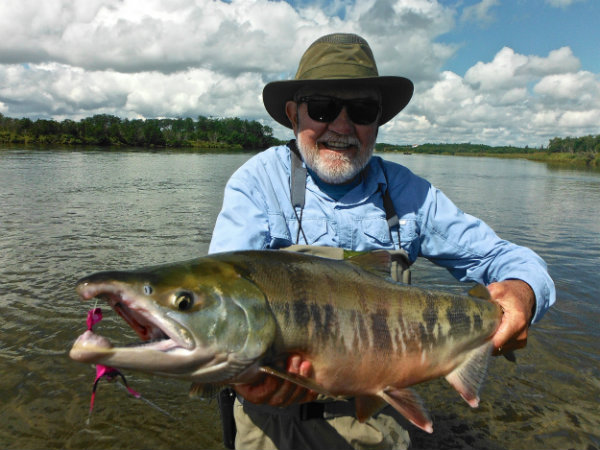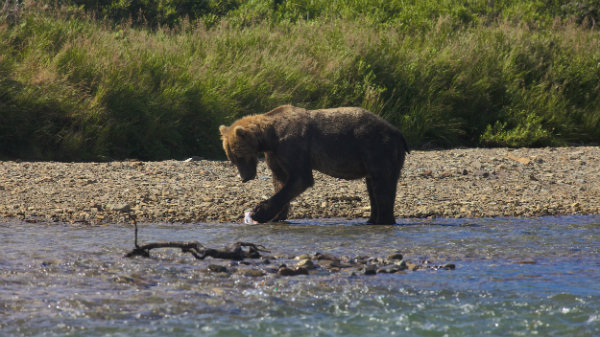
Bob is the editor for the Rocky Mountain Flycaster, the Fort Collins chapter of Trout Unlimited
Although I’m serving my third year as editor of The Flypaper, I’ve only published one article in the RMF newsletter. The regular contributors are competent and well-informed writers with lots to say. So, my job has been very easy. For the most part it has involved cutting and pasting, stuff I learned in the first grade.
The article I wrote for The Flypaper last January contrasted my recent experiences of learning to fly fish with classic (western) methods and the increasingly popular Tenkara (eastern) methods. Until a trip to Alaska during the past summer, the trip I describe in this article, my Tenkara fishing experience had been limited to local (Fort Collins area)
streams and mountain lakes. I had great fun with this minimalist approach in Rocky Mountain National Park, on the Poudre, and in Red Feather Lakes. During the winter of 2014-2015, as I enthusiastically planned my continuing late-in-life
adventures with the fly rod, I happened upon a marvelous video of the Alganak River in Alaska.
This video, recorded from a drone camera, showed huge pods of Pacific Salmon, wondrously beautiful, existential fish, as they doggedly, and seemingly happily, pursued their ultimate destiny. After that brief but captivating viewing, I immediately upgraded an Alaska fishing trip to position number one on my bucket list; shortly thereafter, with matching impulsivity, I decided to try to catch a salmon on a Tenkara rod. Motivated by those fish I “seized the day” “and quickly signed up for a late July/early August fishing trip on the Alganac River at the Anglers Alibi Lodge http://www.anglersalibi.com/; and, almost immediately bought the largest Tenkara rod I could find. There was something about the elegance and simplicity of the lives of those salmon and the Tenkara method that captured me. I knew from the beginning that my Walter Mitty-like dream of catching a big fish on a Tenkara rod was unusual, and also aware this task might be too much of a stretch. Tenkara relies on the simplicity of very long telescoping rods without reels. Ancient
Japanese fisherman who hiked mountains to catch small fish in small mountain streams developed Tenkara as a practical approach to secure food for their families.

My searches on the Internet provided some information about catching larger fish on the Tenkara rod. But the fish I was contemplating were much bigger than those described. Discussions with Colorado Tenkara rod manufacturers Adam Omernick, co-owner of Zen Fly Fishing Gear http://zenflyfishinggear.com/ in Loveland, and Daniel Galhardo,
owner of Tenkara USA in Boulder, were both supportive and encouraging. However, neither Adam nor Daniel had caught a salmon or a 10-pound fish on a Tenkara rod or even known anyone who had. The same was true for John Perry (JP), Owner and Head Guide at Anglers Alibi http://www.anglersalibi.com in Alaska, my destination. Nevertheless, I immediately bought a rod from Adam of Zen Fly Fishing Gear, a friend and fellow member of RMF. I told Adam I wanted the “biggest and sturdiest” rod he made and he suggested the Kyojin, a rod that extends to 12 feet and was designed with a very strong backbone and 8:2 flex ratio. Kyojin roughly translates from the Japanese as “giant” or “huge”; this knowledge immediately gave me a burst of confidence. Indeed, the name of the rod continued to resonate with me and sustain my confidence throughout the trip. Adam also custom rigged a fly line targeted to my objective with an 8 weight running line.

My Goal
When I left for Alaska in late July, my goal was simply to land one of these fish on my new rod. The experts I consulted put my chances for success at 50-50. In spite of their encouragement, each evidenced a similarly skeptical grin when they wished me good luck. Needless to say I was both psyched and challenged by the odds.
The Challenge
Spin fishing and conventional fly fishing for salmon involve casting large lures or flies out into large rivers, setting the hook with a sharp strike, and fighting the fish as it makes runs and jumps. The runs can be fifty to a hundred feet. Even the smaller salmon can take five to ten minutes to bring to the net, and as they approach the net it is common for
a new burst of energy that extends the event. Both fish and fisherman are worn down in the process. The conventional fly rods used on the Alagnak River are 8 weights, 8 to 9 feet in length and with large arbor reels. So how could I expect to catch these fish with a 12-foot telescoping rod, a fragile tip, and a maximum of 15 feet of line – tied directly to the tip?
Preparation
Before helping me try out Tenkara methods, JP rigged a conventional fly rig: an 8-weight rod and reel with an intermediate sinking line, a 5 foot 20 pound test leader and a 15 pound tippet. Catching these marvelous fish with this traditional equipment was a thrill and challenge in and of itself. Although chum salmon are not recognized as elite cuisine, like the Kings and Silvers, they are among the scrappiest fighters of the Pacific salmon species.
Leaders and Knots
After enjoying the thrill of landing several of these fish on the conventional 8-weight fly rod, JP helped me rig the Tenkara rod. We used the Zen fly line customized by Adam. For the first attempt, JP tied a standard nail knot with a 20-pound test leader and attached a pink weighted marabou with a 1/0 saltwater hook. The rig was heavier than anything I had previously cast with the Tenkara rod and it took me several attempts to get accustomed to delivering the fly. Because my Tenkara casts would be shorter, JP looked for and located a pod of fish along the river, and we stealthily walked to a place within reach of them (about 20 feet away). Some of these fish could be seen in the water while others played nearby. Conveniently, all were in shallow water on a sand bar. This afforded me the opportunity to stop an attempted salmon run with my own running! Once I was able to toss the big rig, the take was immediate and vicious. Even more
immediate was the break-off! I wasn’t ready for such brute strength, nor was our rig. The leader broke within a few seconds of the take. I was unprepared by the swiftness of this failure and extremely disappointed. I was about to conclude I wouldn’t land one of these brutes. But JP took it all in stride and set to work designing alternative rigs.
For the second rig, he upped the strength of the leader to 30-pound, doubled it and used a uni-knot to secure it to the fly line. This time I had the fish hooked for 10 to 15 seconds before the line broke at the fly, its weakest point. On our third rig we changed the leader to 40-pound test. The line was almost as thick as the rod tip! We were both elated, after a 10 to 15 minute fight, when the first fish was netted. It had been a team effort. I joyously posed for a picture with the Tenkara rod in my mouth and the fish in my hands, while JP took the photo and shouted TENKARA, TENKARA, TENKARA!!!!
Tenkara Strategy
Once we developed this sturdy rig and had some confidence in it, I was able to work on a strategy for continuing to land subsequent fish. The conventional strategy of letting the fish take line and get tired was obviously not available with a 12-foot line attached to the rod tip. The strategy, developed intuitively, was three-fold: 1) prevent, as much as possible, the angle of the rod from getting below 90 degrees, 2) turn the heads of hooked fish to permit them to run around me and 3) move in repeated 360 degree circles to allow the fish to simulate a “run” without taking line. It was very difficult to maintain the 90 + degree angle of the rod. Old habits and the brute force of the fish require substantial concentration and strength. Over the course of the day, I learned to keep both hands on the rod at all times, one on the handle and another 4 to 6 inches above the handle on the rod itself to get the required strength and leverage. Similarly, turning the head of the
fish to keep them in the desired “orbit” around my body required lots of effort. A back-up strategy, available to me only because the salmon we caught were swimming in shallow waters on long sand bars, was to literally run with the fish when nothing else could be done to avoid breaking the line or the rod. Toward the end of the day I did break the rod. However, the break was all operator error. I got ambitious and decided to land the fish myself, without JP’s assistance. I
succeeded right up to the point where I reached down to grip the salmon’s jaw with the rod held high above my head. This meant that the weight of the fish was pulling straight down, and my rod tip bent too far and snapped. Otherwise the rod performed perfectly. I’ll chase 10-pound fish with it again!
In Summary
Because JP is a wise and experienced professional, my dream of catching a salmon on a Tenkara rig was fulfilled many times over. Indeed, he estimated the number of fish I was able to catch on the Tenkara rod as “double digits” and their weight from 8 to 14 pounds. I’ve learned that guides are more objective reporters of the size and number of fish than clients! But this “catching” didn’t happen immediately. It involved an exploration and a process of trial and error with a number of different leaders and knots, and a subsequent strategy for landing the fish. Needless to say I was joyous about my trip to Alaska and the success of the adventure. Tenkara methods bring me closer to nature and to fish themselves. There is less distance, it seems to me, between the fish and fisherman with Tenkara; and, as an “old guy” I learned to appreciate the existential manner in which these fish enthusiastically celebrate the lives they have lived. They were hatched in the same river a few years before and joyously jump and play as they return to spawn—and to die.




F*ckin’ tremendous issues here. I’m very glad to look your post. Thank you so much and i am taking a look forward to contact you. Will you kindly drop me a mail?
Hey Burt!
Glad you liked the read. What can I do for you?
I’m not sure why but this site is loading extremely slow for me. Is anyone else having this problem or is it a issue on my end? I’ll check back later on and see if the problem still exists.
HI Manuel
Hopefully the page loaded correctly and you enjoyed the read. Let us know if there’s anything we can do for you. Sometimes technology needs a caffeine fix.
I wanted to post you one tiny word to help give thanks once again for your personal amazing pointers you’ve provided on this page. This has been really unbelievably generous of you to give without restraint all a number of us would’ve advertised as an electronic book to make some money on their own, most notably considering the fact that you might have done it in case you considered necessary. The secrets likewise worked as a good way to fully grasp that other people have a similar passion the same as my very own to realize significantly more with regards to this problem. I am sure there are millions of more pleasant sessions up front for folks who examine your blog post.
I like the helpful information you provide in your articles.
I’ll bookmark your blog and check again here regularly.
I am quite sure I’ll learn plenty of new stuff right here!
Best of luck for the next!
Hey amazing post!
I’m planning on skiing denali and pack rafting out. Thinking of bringing a Tankara rod such as this one.
What was the entire fly line you ended up using… was it a doubled up 40lb test and then a 15 lb tippet or what?
For what was landed the set up wasn’t as big….much lighter. Usually 8-10lb test is sufficient unless you are targeting kings or silvers. For Rainbows, char, dollies and grayling 8lb generally works. A 15ft or 20ft line plus leader/tippet works great. The rod was the Sagi.